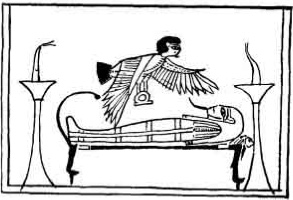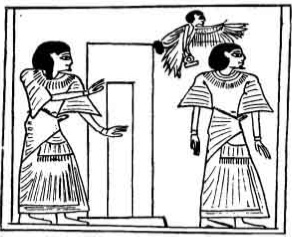Vignettes From the Papyrus of Ani
The soul of the scribe Ani visiting his mummified body as it lies on its bier in the tomb. (From the Papyrus of Ani, plate 17.)
“Many of the pictures or vignettes carry their own interpretations with them, e.g., the picture of the soul hovering over the dead body which lies beneath it on the bier at once suggests the reunion of the soul with the body; the picture of the deceased walking away from a “block of slaughter” and a knife dripping with blood suggests escape from a cruel death; the picture of a soul and spirit standing before an open door suggests that the soul has freedom to wander about at will; and the picture of the soul and the shadow in the act of passing out through the door of the tomb indicates clearly that these parts of man’s economy are not shut up in the tomb for all eternity.
Anubis holding the mummy of the scribe Ani; by the door of the tomb stand the soul and spirit of the deceased in the form of a human-headed hawk and bennu bird respectively. (From the Papyrus of Ani, plate 16.)
But the ideas which prompted the painting of other vignettes are not so clear, e.g., those which accompany Chapters CLXII-CLXV in the late or Säite Recension of the Book of the Dead, although, fortunately, the rubrics to these chapters make their object clear.
Thus the picture which stands above Chapter CLXII. is that of a cow having upon her head horns, a disk, and two plumes, and from the rubric we learn that a figure of it was to be made in gold and fastened to the neck of the deceased, and that another, drawn upon new papyrus, was to be placed under his head.
If this be done “then shall abundant warmth be in him throughout, even like that which was in him when he was upon earth. And he shall become like a god in the underworld, and he shall never be turned back at any of the gates thereof.”
The scribe Ani passing through the door of the tomb. Outside are his shadow and his soul in the form of a human-headed bird. (From the Papyrus of Ani, plate 18.)
The words of the chapter have great protective power (i.e., are a charm of the greatest importance) we are told, “for it was made by the cow for her son Râ when he was setting, and when his habitation was surrounded by a company of beings of fire.”
E.A. Wallis Budge, Egyptian Magic, London, 1901. Pp. 113-6.



